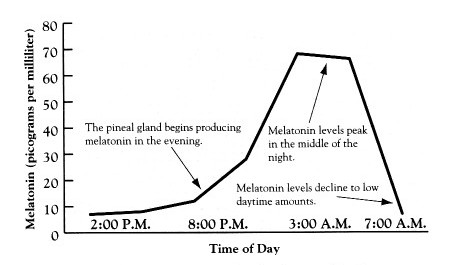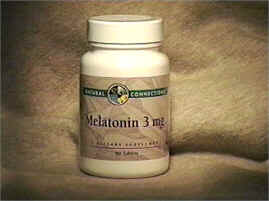

Melatonin or 5-methoxy-N-acetyltryptamine is an important hormone that plays a role in regurating the neuroendocrine system. It plays an important role in the reguration of the circadian sleep-wake cycle. It also controls essential functions such as metabolism, sex drive, reproduction, appetite, balance, muscular coordination and immune system in fighting off diseases triggered by bacteria, viruses, chemical pollutants and excessive free radical activity. It is normally released during the night in response to environmental changes in light levels by the peneal gland which is a tiny gland burried deep in the brain behind the eyes of mammals. The pineal itself is controlled by a paired cluster of nerve cells located just above the optic chiasm in the hypothalamus. These cells are known as the suprachiasmatic nuclei (SCN) and they contain the circadian pacemaker. Each night the SCN send impulses, via a series of neurons in the hypothalamus and spinal cord, up to the pineal gland to stimulate melatonin secretion. The timing mechanism in the SCN itself is controlled by sunlight that enters the retina and reaches the SCN via the retinohypothalamic pathway. The amount of melatonin circulating in the blood has been shown to rise and fall during a day. The 24-hour cycle of melatonin production in Human is shown in figure 1 below;

Since its structure was first discovered in 1958 by A.B. Lerner![]() ,
melatonin has been studied extensively. There are over 4,000 published
studied in the scientific literature about melatonin. Every week, five
to fifteen new studies are published, making melatonin one of the hottest
subjects of life extension research. In toxicity studies conducted on humans,
doses of melatonin ranging from 300 mg a day for nine months to 1000 mg
a day for six weeks porduced no toxicity or adverse reactions other than
daytime fatigue
,
melatonin has been studied extensively. There are over 4,000 published
studied in the scientific literature about melatonin. Every week, five
to fifteen new studies are published, making melatonin one of the hottest
subjects of life extension research. In toxicity studies conducted on humans,
doses of melatonin ranging from 300 mg a day for nine months to 1000 mg
a day for six weeks porduced no toxicity or adverse reactions other than
daytime fatigue![]() .
.
 So what is so hot about melatonin ?
So what is so hot about melatonin ?
Melatonin is an effective sleeping pill. Taking low dose of melatonin on a nightly basis at appropriate sleep times allows the body to naturally adapt to altered day and night patterns. Synthesis of melatonin in the human body declines with advancing age and this is one of the reasons why elders have more sleep disorder problems than children.
Research shows that the administration
of melatonin improves the sleep onset in blind subjects unable to
synchronize with the solar cycle![]() .It
may also be an effective hypnotic for insominiacs or travellers who suffer
from jet lag. In 1994 Wurtman et al. at the Massachusetts Institute of
Technology reported the results of a sleep laboratory study involving 20
subjects with normal sleep habits. Subjects were administered melatonin
in low doses (1-10 mg) or placebo, and sleep was monitired in the lab during
five 8-hour test sessions. Compared with placebo, melatonin (all doses)
decreased the time it took to fall asleep and increased sleep duration.
Subjects who received melatonin 1 mg fell asleep in an average of 6 minutes
compared with 17 minutes for subjects who received placebo. The investigators
concluded that melatonin may be as effective a hypnotic as the benzodiazepines
.It
may also be an effective hypnotic for insominiacs or travellers who suffer
from jet lag. In 1994 Wurtman et al. at the Massachusetts Institute of
Technology reported the results of a sleep laboratory study involving 20
subjects with normal sleep habits. Subjects were administered melatonin
in low doses (1-10 mg) or placebo, and sleep was monitired in the lab during
five 8-hour test sessions. Compared with placebo, melatonin (all doses)
decreased the time it took to fall asleep and increased sleep duration.
Subjects who received melatonin 1 mg fell asleep in an average of 6 minutes
compared with 17 minutes for subjects who received placebo. The investigators
concluded that melatonin may be as effective a hypnotic as the benzodiazepines![]() .
.
Apart from its treat with sleeping disorders, there is also a correlation between the low level of melatonin and increase in risk of cancer. Research studies have demonstrated that melatonin can prevent chemically induced mammary tumors in laboratory rats and can also inhibit the proliferation of human breast cancer cells in tissue culture. For more detail about role of melatonin concerning cancer and tumer see melatonin immunity and cancer in human.
Melatonin is available commercially
from several unregurated health-food suppliers. Soon after the publication
of the Wurtman report, health food stores began selling out of melatonin
and consumers flooded Wurtman's lab with requests for melatonin for insominia
or jet lag. The response to these requests has been to point out that melatonin
is not FDA approved. There is no labeling for dosage and side effects,
there are no controls for purity and self-medicating with an unregulated
product is a mistake.However, melatonin demand has not yet declined. In
1994, one manufacturer of melatonin in USA increased the amount
of melatonin sold the previous year by three-fold![]() .
.
 What to consider before using melatonin
What to consider before using melatonin
supplement?
The first thing to consider
is that sometimes, less is more. Although melatonin plays an extremely
important role in our bodies, it is present only in tiny amounts, even
when we are at our youthful peak. Melatonin capsules vary in dosage from
less than 0.1 mg up to 6 mg. Although no severe side effects have
been reported at dosages up to 10 mg daily, in some people it may cause
morning drowsiness. Melatonin is not recommended for pregnent women
nor should be intended to use by persons under 25 years of age. People
who have serious illnesses such as autoimmune disorder, leukemia or lymphoma
should consult a physician familear with melatonin before usage. Immune
suppressing drugs such as cortisol and cyclosporine may react adversely
with melatonin as may anti-depressants. People who are diabetic, experience
major depression or have a hormonal imbalance should also take caution.
Pregnent of nursing mather should avoid melatonin supplements. They are
already transmitting melatonin to fetus or infant via the placenta or their
milk. It is unknown if increasing their own melatonin levels might adversely
affect the child.

